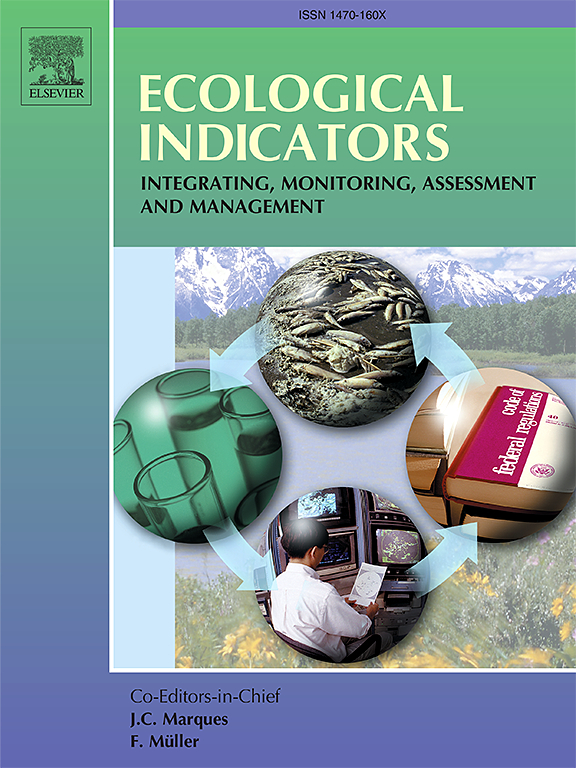Soundscape analysis reveals fine ecological differences among coral reef habitats
IF 7
2区 环境科学与生态学
Q1 ENVIRONMENTAL SCIENCES
引用次数: 0
Abstract
Recording soundscapes in coral reef ecosystems provides an efficient, non-invasive method for ecosystem monitoring and conservation. This study assesses the ecological relevance of coral reef soundscapes, validating their utility for conservation decision-making. Using the Soundscape Code—a method that summarizes soundscape amplitude, impulsiveness, periodicity, and uniformity—we analyzed habitat differentiation across 25 simultaneous recordings from back, flat, and fore reef zones. Benthic composition analysis identified two distinct healthy habitat types: one dominated by branching corals and another without a dominant coral growth form. Acoustic analysis revealed these habitats also had unique nighttime soundscapes, driven by amplitude (loudness) and uniformity (sound diversity) differences linked to fish and invertebrate activity. This alignment between benthic structure and nocturnal soundscape patterns suggests that reef soundscapes reflect both benthic composition and the associated biological communities, including cryptic invertebrates and nocturnal fish. Our findings underscore the potential of nighttime soundscapes and the Soundscape Code as valuable tools for coral reef monitoring and management, with practical applications for ecosystem assessment and restoration planning.
记录珊瑚礁生态系统中的声音景观为生态系统监测和保护提供了一种高效、非侵入性的方法。本研究评估了珊瑚礁声景的生态相关性,验证了其在保护决策中的实用性。利用声景代码--一种概括声景振幅、冲动性、周期性和均匀性的方法--我们分析了来自后礁、平礁和前礁区的 25 个同步录音的生境分异。底栖生物组成分析确定了两种不同的健康栖息地类型:一种以枝状珊瑚为主,另一种没有主要的珊瑚生长形式。声学分析表明,这些栖息地也有独特的夜间声景,其驱动因素是与鱼类和无脊椎动物活动相关的振幅(响度)和均匀性(声音多样性)差异。海底结构与夜间声景模式之间的这种一致性表明,珊瑚礁声景既反映了海底组成,也反映了相关的生物群落,包括隐蔽的无脊椎动物和夜间活动的鱼类。我们的研究结果强调了夜间声景和声景代码作为珊瑚礁监测和管理的宝贵工具的潜力,以及在生态系统评估和恢复规划方面的实际应用。
本文章由计算机程序翻译,如有差异,请以英文原文为准。
求助全文
约1分钟内获得全文
求助全文
来源期刊

Ecological Indicators
环境科学-环境科学
CiteScore
11.80
自引率
8.70%
发文量
1163
审稿时长
78 days
期刊介绍:
The ultimate aim of Ecological Indicators is to integrate the monitoring and assessment of ecological and environmental indicators with management practices. The journal provides a forum for the discussion of the applied scientific development and review of traditional indicator approaches as well as for theoretical, modelling and quantitative applications such as index development. Research into the following areas will be published.
• All aspects of ecological and environmental indicators and indices.
• New indicators, and new approaches and methods for indicator development, testing and use.
• Development and modelling of indices, e.g. application of indicator suites across multiple scales and resources.
• Analysis and research of resource, system- and scale-specific indicators.
• Methods for integration of social and other valuation metrics for the production of scientifically rigorous and politically-relevant assessments using indicator-based monitoring and assessment programs.
• How research indicators can be transformed into direct application for management purposes.
• Broader assessment objectives and methods, e.g. biodiversity, biological integrity, and sustainability, through the use of indicators.
• Resource-specific indicators such as landscape, agroecosystems, forests, wetlands, etc.
 求助内容:
求助内容: 应助结果提醒方式:
应助结果提醒方式:


